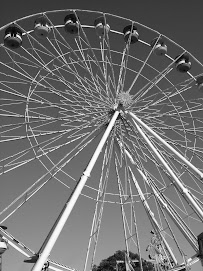| bazaars |
Bazaar: [buh-zahr], –noun, a marketplace or shopping quarter, esp. one in the Middle East.
This is a permanent setting which is many times located outdoors. A bazaar is a place where items are bought, sold, and traded. It is many times a street where vendors gather linearly in tent like structures.



| market |
market: [mahr-kit], –noun, an open place or a covered building where buyers and sellers convene for the sale of goods; a marketplace: a farmers' market.
Similiar to a bazaar except for it is usually not permanent. Vendors set up shop at the begining of the day and usually tear down at the end. Farmers markets are outdoor markets where local farmers bring their items to sell. The items are very fresh, organic and natural. This supports local economy and builds community.


| plazas |
plaza: [plah-zuh, plaz-uh], –noun, a public square or open space in a city or town.
Usually centrally located. It is also used for meetings as well as events. So there is a focus on community.
Similiar to an Italian Piazza, focus on centrality, community, culture.


| malls |
mall:[mawl; Brit. also mal], –noun, 1. Also called shopping mall. a large retail complex containing a variety of stores and often restaurants and other business establishments housed in a series of connected or adjacent buildings or in a single large building.
A series of individual stores seperated by walls. usually have some type of communal area in the center. The series of stores usually share one roof but sometimes it might be an outdoor mall so the passageways to and from each store would be located outdoors instead of in.


| promenade |
promenade: [prom-uh-neyd, -nahd], -noun, 1. a stroll or walk, esp. in a public place, as for pleasure or display, to conduct or display in or as if in a promenade; parade:
The reason why I added this to the mix is because of my experience in California this summer. I stayedin Venice beach this summer (which by the way the streets there were lined with vendors which very much reminded me of a bazaar according to the definition above.) but every night we would go to Santa Monica where a few of the streets were lined with wellknown stores (gap,forever 21, starbucks,levi etc. ) except they wrere all threestories and huge!. The name of this experience was the third street promenade. It was basically a few city blocks and the streets were paved with bricks for walking and bikes only. The streets were also filled with music as bands, singers, and talent shows performed. it was great.







(the last image is of the third street promenade in the 1880s.)
I see this space as a combination of the promenade, bazaar, and even the plaza.. What is going on the outside is so special ( the creek running through) that it draws people outdoors, while those left inside still have the views from the large windows. The exterior walkway and gathering space to me is reminscent of both the promenade ( because of the long walkway) and the plaza ( because of the centrality and courtyard effect). While the inside is more like a bazaar running in and out of the building in a more permanent sense.
photos and information courtesy of:
www.wikipedia.com
vikramdhunta.com/blog
ecdowntownfarmersmarket.com
archive.ci.falcon-heights.mn.us
www.chicagoantiquemarket.com
www.oconnor-group.com/LincolnPlace.asp
www.pbase.com/rljslick/image/28071223
www.wehrleweb.de
www.dictionary.com
www.answers.com









































